Azima tetracantha
Azima tetracantha Lam.
Family: Salvadoraceae
Common names: bee-sting bush, needle bush, four-thorns, stink bush (Eng.); byangelbos, groendoring, spelddoring, naaldebos, naaibos, stinkbos (Afr.); igcegceleya, igceya (isiXhosa); murunda (Tshivenda); umgeza, ingungumela, isikhumukele (isiZulu); ribaba (Setswana)
SA Tree No: 622.1
Introduction
Azima tetracantha is an ornamental, scrambling shrub, with interesting tetragonal branches and large spines.
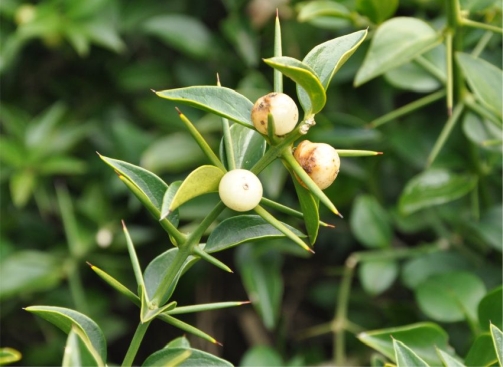
Description
Description
This is a dense, evergreen shrub or scrambler that grows to a height of 2-3 m. The leaves are simple, pungent, pretty and oval, mid to light green and glossy. It has light brown bark that is rough, with soft white wood. The branches are tetragonal, pubescent when young and later glabrous. They are heavily armed with slender, sharp spines, two in each axil resulting in a whorl of four at each node, 28 up to 50 mm long, and often longer than the leaves. The flowers are tiny, solitary or in spikes 2–5 mm long, greenish to yellow, from one to a few in the axils, and occur in summer, from October to February. Attractive yellowish to white berries, translucent when ripe, occur after flowering.
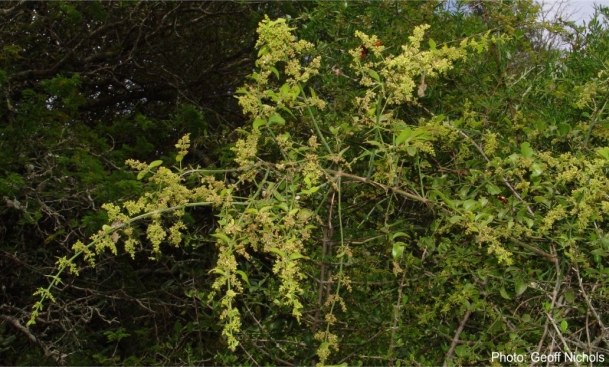
Azima tetracantha is dioecious meaning there are separate male and female trees.
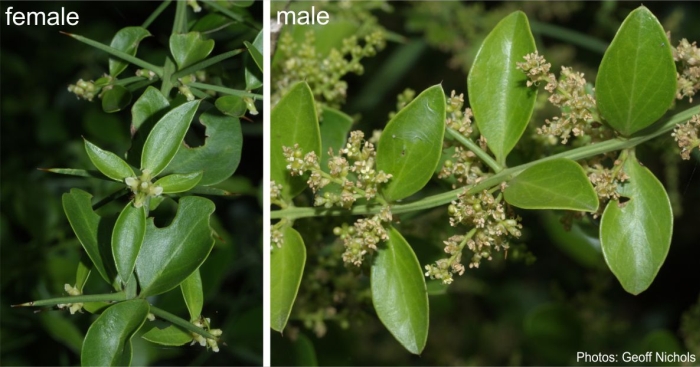
Conservation Status
Status
Azima tetracantha is not threatened and falls under the category of Least Concern (LC), according to the SANBI Red List of South African Plants. This species is not endemic to South Africa.
Distribution and habitat
Distribution description
Azima tetracantha occurs from Cape Infanta in South Africa to tropical Africa. In South Africa it is found in the following provinces: Western Cape, Eastern Cape, KwaZulu-Natal and Mpumalanga. It occurs in lowland scrub, forest, mangrove edges, sea-dunes, coastal bushland, not far from the high-water mark.
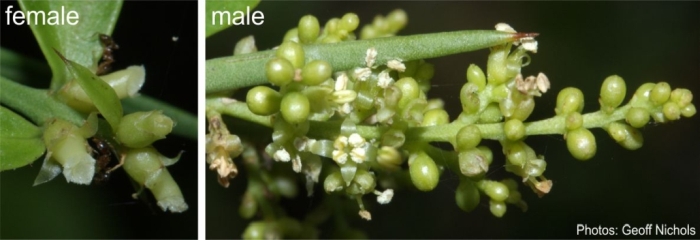
Derivation of name and historical aspects
History
Azima is a small genus of plants in the family Salvadoraceae. There are 3 known species around the world with only one species occurring in central, eastern and southern Africa.
The name Azima is of Arabic origin and means ‘defender’. The species name means ‘four thorns’ from the Greek tetra meaning ‘four’ and akantha, meaning ‘thorns’.
A wound, small or large, caused by one of the spines is very painful, hence one of the common names, bee-sting bush. This would also explain the scientific names of the plants, where the stems are four-sided and the spines occur in fours at the nodes, as well as the spines being long and sharp and acting as defenders or protectors.
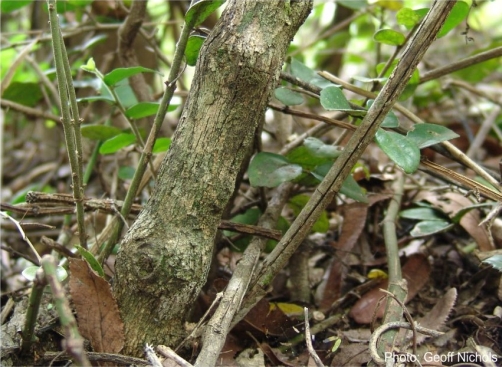
Ecology
Ecology
The beautiful, white, translucent berries are eaten by goats and other stock and they impart a very pronounced flavour to both milk and butter. The berries are also eaten by birds.
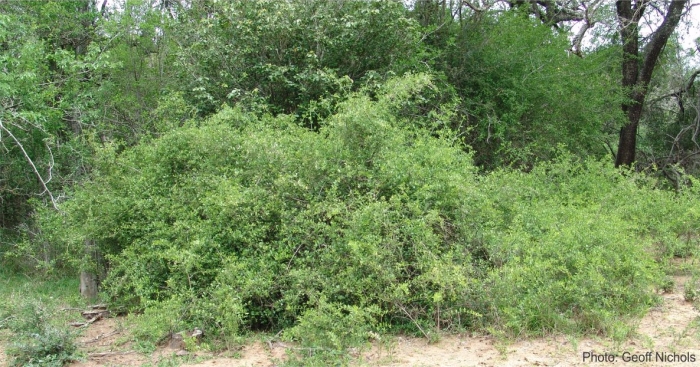
Uses
Use
Azima tetracantha is rich in medicinal properties as a result different parts of the plant have a variety of uses. The root, root bark sap and leaves of the bee-sting bush, are used both internally and externally. It is used as a folk medicine in Africa, Sri Lanka and India. Due to its powerful diuretic activity, it is given in rheumatism, dropsy, dyspepsia and chronic diarrhea. It is also given as a stimulant tonic after confinement. The leaf juice given internally relieves cough phthisis and is applied as eardrops against earache. The crushed leaves are placed on painful teeth. It can also be used to treat snake bites, stomach disorders and as a uterine tonic. The smoke from its wood is unfortunately poisonous and therefore cannot be used as fuel but only in the production of fencing.
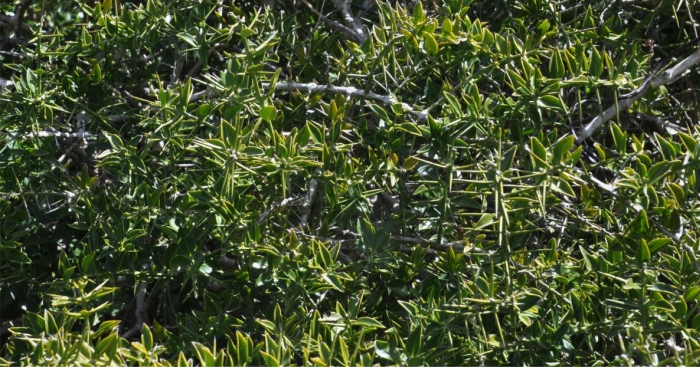
Growing Azima tetracantha
Grow
This species is propagated via seed and cuttings. Seeds may be sown and cuttings taken at any time of the year. Seeds may be sown in a mixture of coir or a sowing mix that consists of sand or perlite. Place in a bright area and keep constantly moist, but not wet, until germination takes place.
Once the plant has established fertilize at least once a year. It is a fast grower so it may need transplanting into a bigger size yearly or every second year if it is kept as a pot plant. It grows well in full sun.
It is best used as a hedge plant and is very good for beefing up security as it has strong spines and forms a dense, impenetrable barrier. Can be used as a pot plant.
Known pests are spider mites.
References
- Anupama. 2017. Kundali (Azima tetracantha) information, classification and medicinal uses. bimbima. Online. https://www.bimbima.com/herbs/azima-tetracantha/3603/. Accessed 11 Aug 2022.
- Batten. A. & Bokelmann, H. 1966. Wild flowers of the Eastern Cape Province. Books of Africa, Cape Town.
- Dold, A.P. 2006. Azima tetracantha Lam. PROTA4U. Online. https://www.prota4u.org/database/protav8.asp?g=psk&p=Azima%20tetracantha. Accessed on 15/09/22.
- Explore Baby Names, Azima. https://www.explorebabynames.com/meaning-of-azima. Accessed on 21/09/22.
- Manning, J. & Goldblatt, P. 2012. Plants of the Greater Cape Floristic Region 1: the Core Cape Flora. Strelitzia 29. South African National Biodiversity Institute, Pretoria.
- Herbpathy, Azima tetracantha herb, uses, benefits, cures, side effects, nutrients repertory. https://herbpathy.com/Uses-and-Benefits-of-Azima-Tetracantha-Cid5329. Accessed 18 Aug 2022.
- Honig, M. 2014. Indigenous plant palettes. Quiver Tree Publications, Cape Town.
- Operation Wildflower, Azima tetracantha. https://www.operationwildflower.org.za/index.php/plant-records/trees/162-azima-tetracantha. Accessed 8 Aug 2022.
- Verdoorn, I.C. 1963. Salvadoraceae. Flora of southern Africa Volume 26: 128–134. Accessible via Biodiversity Heritage Library. https://www.biodiversitylibrary.org/item/209561#page/141/mode/1up.
- Wikipedia, Azima tetracantha. https://en.wikipedia.org/wiki/Azima_tetracantha. Accessed 18 Aug 2022.
Credits
Sisanda Velembo
Kirstenbosch National Botanical Garden
September 2022
Acknowledgements: the author thanks Geoff Nichols and Alice Notten for providing the images.
Plant Attributes:
Plant Type: Scrambler, Shrub
SA Distribution: Eastern Cape, KwaZulu-Natal, Mpumalanga, Western Cape
Soil type: Sandy, Loam
Flowering season: Early Summer, Late Summer
PH: Acid, Neutral
Flower colour: Green, Yellow
Aspect: Full Sun
Gardening skill: Average
Special Features:
Horticultural zones









Rate this article
Article well written and informative
Rate this plant
Is this an interesting plant?
Login to add your Comment
Back to topNot registered yet? Click here to register.